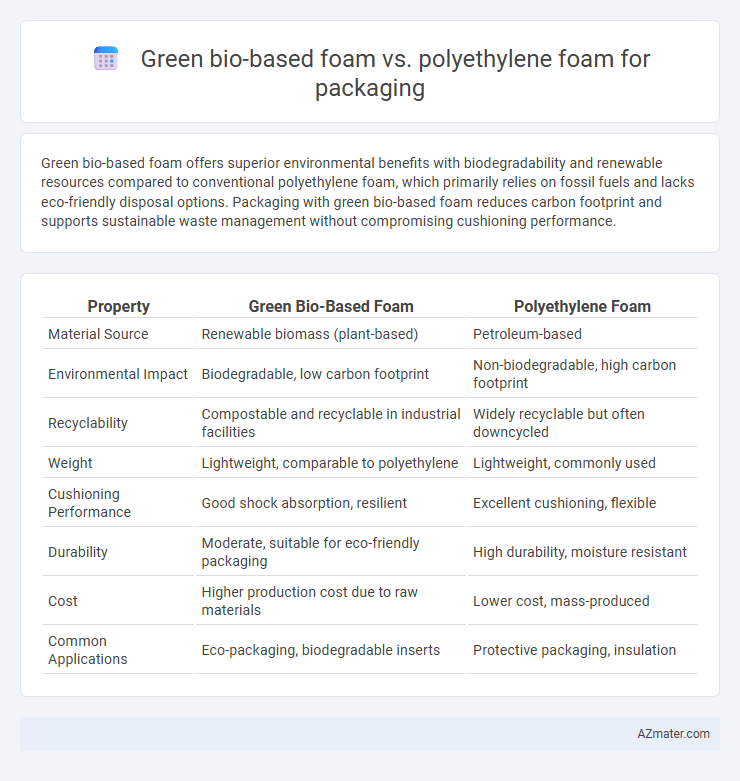Green bio-based foam offers superior environmental benefits with biodegradability and renewable resources compared to conventional polyethylene foam, which primarily relies on fossil fuels and lacks eco-friendly disposal options. Packaging with green bio-based foam reduces carbon footprint and supports sustainable waste management without compromising cushioning performance.
Table of Comparison
| Property | Green Bio-Based Foam | Polyethylene Foam |
|---|---|---|
| Material Source | Renewable biomass (plant-based) | Petroleum-based |
| Environmental Impact | Biodegradable, low carbon footprint | Non-biodegradable, high carbon footprint |
| Recyclability | Compostable and recyclable in industrial facilities | Widely recyclable but often downcycled |
| Weight | Lightweight, comparable to polyethylene | Lightweight, commonly used |
| Cushioning Performance | Good shock absorption, resilient | Excellent cushioning, flexible |
| Durability | Moderate, suitable for eco-friendly packaging | High durability, moisture resistant |
| Cost | Higher production cost due to raw materials | Lower cost, mass-produced |
| Common Applications | Eco-packaging, biodegradable inserts | Protective packaging, insulation |
Introduction to Packaging Foams
Green bio-based foam offers a sustainable alternative to traditional polyethylene foam in packaging, utilizing renewable resources such as plant oils and starches to reduce environmental impact. Polyethylene foam, known for its excellent cushioning, shock absorption, and moisture resistance, remains widely used due to its durability and cost-effectiveness. Comparing the two highlights bio-based foam's biodegradability and lower carbon footprint, while polyethylene foam excels in chemical stability and long-term protection for fragile goods.
Overview of Green Bio-Based Foam
Green bio-based foam is derived from renewable resources such as plant oils, starches, and cellulose, offering an eco-friendly alternative to conventional polyethylene foam commonly used in packaging. This sustainable material provides comparable cushioning, shock absorption, and lightweight properties while significantly reducing carbon footprint and dependence on fossil fuels. Biodegradability and compostability of green bio-based foams contribute to minimizing environmental pollution and promoting circular economy practices in packaging industries.
Key Properties of Polyethylene Foam
Polyethylene foam for packaging offers exceptional impact absorption, moisture resistance, and chemical stability, making it ideal for protecting delicate items during shipping. Its lightweight nature combined with excellent cushioning properties ensures efficient handling and reduced shipping costs. Unlike green bio-based foam, polyethylene foam provides superior durability and longer shelf life in various environmental conditions.
Environmental Impact Comparison
Green bio-based foam offers significant environmental benefits over polyethylene foam due to its renewable raw materials derived from plant sources, which reduce reliance on fossil fuels and lower carbon footprints. Unlike polyethylene foam, which is petroleum-based and contributes to long-lasting plastic waste, bio-based foam typically exhibits enhanced biodegradability and compostability, minimizing landfill accumulation and environmental pollution. Life cycle assessments reveal that bio-based foam production emits fewer greenhouse gases and consumes less energy, making it a more sustainable packaging choice for reducing environmental impact.
Performance and Durability Analysis
Green bio-based foam offers enhanced environmental sustainability with comparable cushioning and shock absorption properties to traditional polyethylene foam, making it a viable alternative for eco-conscious packaging demands. Polyethylene foam exhibits superior resistance to moisture, chemicals, and long-term compression set, ensuring consistent performance in harsh or prolonged storage conditions. When analyzing durability, polyethylene foam generally outperforms bio-based variants in maintaining shape and protective function over extended periods, though advancements in bio-based foam formulations are narrowing this gap.
Cost and Economic Considerations
Green bio-based foam typically incurs higher initial costs compared to conventional polyethylene foam due to raw material sourcing and production processes. However, reduced environmental impact and potential regulatory incentives can offset expenses in the long term, promoting sustainable packaging solutions. Companies face trade-offs between upfront investment and lifecycle savings when evaluating these materials for cost-effective packaging.
Biodegradability and End-of-Life Options
Green bio-based foam offers superior biodegradability compared to traditional polyethylene foam, breaking down naturally within months under industrial composting conditions. Polyethylene foam, derived from non-renewable petroleum, persists in landfills for centuries, posing significant environmental challenges due to its resistance to microbial degradation. End-of-life options for green bio-based foam include composting and anaerobic digestion, whereas polyethylene foam is primarily limited to recycling, incineration, or landfill disposal, often resulting in higher carbon footprint and environmental impact.
Regulatory and Industry Standards
Green bio-based foam aligns with increasingly stringent environmental regulations such as the EU's Packaging and Packaging Waste Directive and the U.S. EPA's Sustainable Materials Management programs, promoting compostability and reduced carbon footprints. Polyethylene foam complies with industry standards like ASTM D3575 for physical properties and ASTM D6400 for compostability only when specifically formulated, but typically faces challenges meeting biodegradability criteria. Certification bodies such as OK compost and TUV Austria bolster the compliance credentials of bio-based foams, whereas polyethylene foams often require recycling programs to meet regulatory expectations.
Market Adoption and Consumer Trends
Green bio-based foam is gaining significant market adoption driven by increasing consumer demand for sustainable and eco-friendly packaging solutions, with a global market CAGR projected at over 15% through 2028. Polyethylene foam maintains strong presence due to cost-effectiveness, superior cushioning properties, and widespread industrial use, but faces growing regulatory pressures and shifting consumer preferences towards biodegradable alternatives. Consumer trends emphasize transparency, carbon footprint reduction, and recyclability, accelerating the shift towards bio-based foam in sectors like electronics, food, and e-commerce packaging.
Future Prospects in Sustainable Packaging
Green bio-based foam, derived from renewable resources like plant starches and algae, offers promising future prospects in sustainable packaging due to its biodegradability and reduced carbon footprint compared to traditional polyethylene foam. Advanced bio-foam technologies aim to enhance material strength and thermal stability, making them viable alternatives for protective packaging demands. Increasing regulatory pressures and consumer demand for eco-friendly solutions are driving innovation and market expansion in bio-based packaging materials.

Infographic: Green bio-based foam vs Polyethylene foam for Packaging
 azmater.com
azmater.com